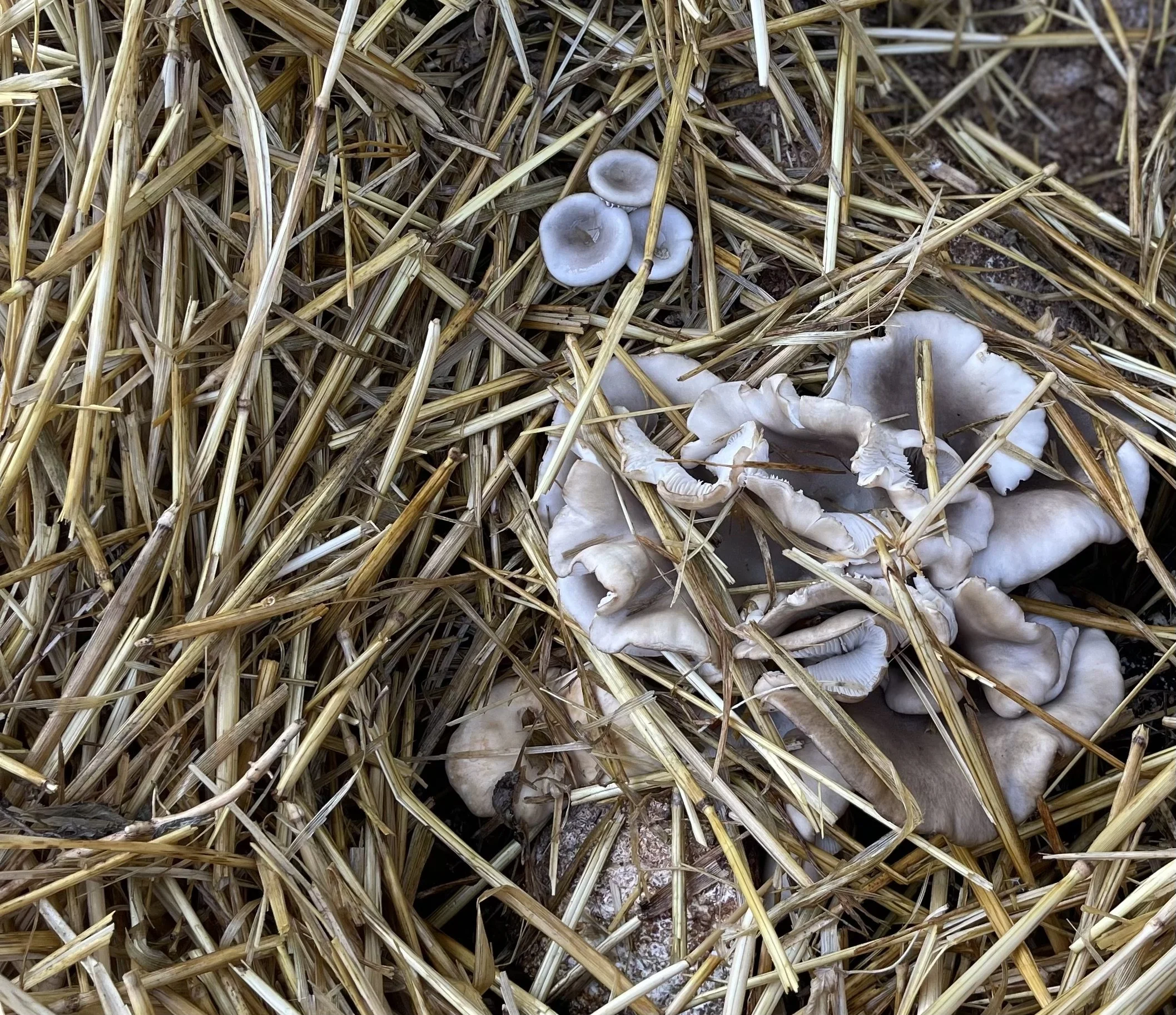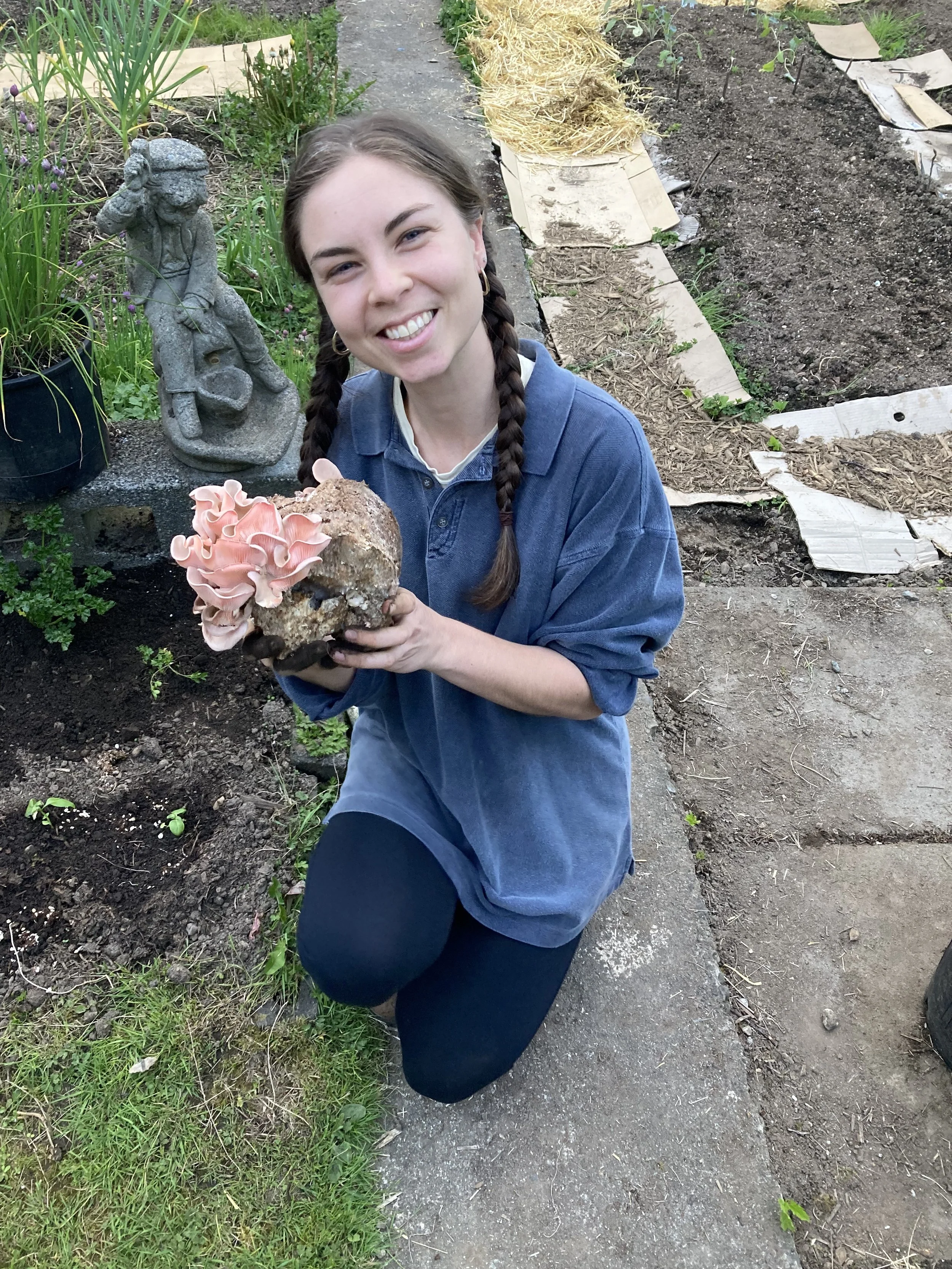Growing Mushrooms in Your Garden
Introduction
Have a shady spot in the garden? Food can be grown in all areas of the garden - sun or shade! Just like tomatoes grow well in a sunny spot of a garden, mushrooms grow well in a shady spot.
Gather Gardeners and Circular Harvest have partnered to share how to increase the harvest in your garden by growing mushrooms. There are many types of mushrooms that grow well in the garden. This article will share step-by-step instructions on how to successfully grow wine cap and oyster mushrooms in a garden bed and how growing mushrooms in the garden improves the health of the garden. The mushrooms are also delicious to eat! Inspirational recipes that include seasonal mushroom and vegetable pairings will be shared.
Why Grow Mushrooms Outdoors?
There are many benefits to growing mushrooms in the garden aside from eating them! An expanded mycelial network (the root system of Fungi) in the soil provides the garden’s ecosystem with opportunities to heal and flourish. Three benefits that will be explained are pest populations, garden pathways and soil health.
1) Pest Populations
Every gardener understands the struggle of ensuring your vegetables are not damaged or eaten before it’s ready to harvest. By adding mushroom mycelium to the garden, slugs can be diverted away from your vegetables by eating the mushrooms first. This is known as a “trap crop”.
Fruiting mushrooms may also attract predatory organisms to pests. By growing a tasty crop for birds, spiders and other beneficial creatures, populations of pests that damage and eat your vegetables will reduce. Mycelium also competes with pests for resources, which reduces the population density of pests overtime.
Mushrooms do not repel pests away; however, the mycelium forms a symbiotic relationship with the soil microorganisms. This means a relationship between Fungi and organisms that make up a healthy soil ecosystem will strengthen, which will improve the health and stress-tolerance of the vegetable plants growing in the garden. This helps suppress the growth of harmful pathogens in the soil, reduces the prevalence of soil-borne pests and diseases, and provides more opportunities for the vegetable roots to access water and nutrients from an expanded network of mycelium.
2) Garden Pathways
Many gardeners use pathways as a safe space to walk in the garden. However, the pathways can be multi-functional by producing food.
Mushrooms can be grown in most areas of the garden with the pathway as no exception. If you follow the steps below on how to spread grain spawn (similar to seeds) in the pathways, then a bonus crop may grow in the spring and fall. Oftentimes, this area of the garden is left bare or gravel is added to prevent growth of any crop. Instead, create an environment for mushrooms to grow. This can also be done in between rows of long-growth plants.
All gardens need weekly weeding in the pathways during the growing season so that grass and other weeds do not spread easily to the vegetable crops. When straw and grain spawn is added to the pathways, this is naturally a weed suppressant. By adding hardwood mulch AND mycelium, the pathways go from low-maintenance to low-maintenance AND food-producing.
Mulching with straw or hardwood sawdust/chips provides many benefits other than weed-suppressant and food-production. Do not mulch with hay as this may have weed seeds in the dried grass. By mulching, the nutrients and moisture in the soil are retained for longer periods of time. This is especially helpful as climate change is creating harsher and longer droughts during the summer months. Therefore, the moisture and nutrients in the soil will be able to withstand more stressful climatic events such as heat waves.
3) Soil Health
An important lesson for new gardeners is to not feed the plants, but to feed the soil. The health of the soil determines the health of all the plants in the garden.
Mycelium has a vital role in the healing and health of the soil and therefore the plants. The soil is not healthy without the presence of mycelium in the garden. A healthy mycelium network stays established with no-till growing practices. This prevents soil erosion and topsoil loss during high rainfall and flooding events, especially in Pacific Northwest climates.
Other benefits in the soil are the acceleration of dead matter decomposition that creates organic matter and nutrients available to the plants for uptake. This means a higher quality soil that will not stunt plant growth, but larger harvests. Another benefit of mycelium expanding in the soil is the ability to remove toxins. This is especially useful in urban gardening when toxins, such as lead and mercury can be found present in the soil (Source). Once the mushrooms remove the toxin from the soil, the harvest is inedible as the toxin will be in the mushrooms!
The most impactful benefits of mycelium for the garden’s soil is the network of nutrients and moisture that the plant roots now have access to, such as: sucrose, carbon, and water. For example, a tomato plant can access water during a summer drought even if its roots have not grown enough to reach moisture in the soil. If the tomato plant has a symbiotic relationship with Fungi, imagine the mycelial network is a spider web in the soil and acts like a highway for water to be transported to the roots. This will result in a healthy tomato plant and therefore, an increase in the tomato harvest for you to eat!
Mushrooms that Grow Well in the Garden
More than 10,000 types of mushrooms exist on the planet. You may find many of those growing in your garden. There are three common types of mushrooms:
1. Saprophytic mushrooms grow by breaking down dead and decaying wood and absorbing its nutrients. A common example is the are oyster mushroom (Pleurotus ostreatus).
2. Mycorrhizal mushrooms grow by forming a symbiotic relationship with plant roots, exchanging carbon and nutrients. A common example is the wine cap mushroom (Stropharia rugosoannulata).
3. Parasitic mushrooms grow by breaking down the organic matter of living organisms. A common example is the chaga mushroom (Inonotus obliquus).
A common mushroom that grows well in the garden include wine cap mushrooms, also known as King Stropharia or Garden Giant which grow well in wood chips piles, compost piles or mulched garden beds. They have a mild, nutty flavour. Be careful to accurately identify this mushroom as there are toxic look-alikes such as the Cortinarius species.
Gardeners grow wine cap mushrooms not only to consume but also to break down organic matter such as wood chips, straw, leaves and other plant debris, and improve soil health by contributing to the formation of humus-rich soil. The mycelium of wine cap mushrooms enhances soil aggregation and soil aeration, promoting root growth. Wine cap mushroom mycelium also releases nutrients such as nitrogen, phosphorus and potassium into the soil to be absorbed by plant roots in a symbiotic relationship.
Other benefits of wine cap mycelium include the ability to bind soil particles together, reducing erosion and soil loss in garden beds. This helps prevent nutrient runoff, preserving soil fertility and ecosystem integrity.
You can also grow oyster mushrooms in your garden, however being saprophytic, they need a refreshed supply of sawdust or mulch each season to continue growing mushrooms.
Growing Shiitake Mushrooms on Logs
Growing shiitake mushrooms from logs is another popular way to grow mushrooms outside. Stay tuned for another blog post featuring how to do exactly this!
“How-To” Grow Mushrooms in the Garden
Step #1: Gather Supplies
Grain spawn / spent substrate
Hardwood sawdust
Straw
Step #2: Select a Suitable Location
Choose a shaded area in you garden that receives indirect sunlight
Step #3: Choose a Growing Substrate (Medium)
Do not add sawdust directly into soil. If blended/tilled into the soil, the plant growth MAY be stunted.
Make sure the wood is not treated (no chemicals or salts). You don’t want those added to the soil.
Do not use wood from a walnut tree! It contains a plant-suppressing chemical called juglone (Link).
Straw, hardwood sawdust and mulch are a popular choice.
Step #4: Layer Substrate and Grain to Inoculate
Layer 2-parts hardwood sawdust/mulch to 1-part grain spawn equally overtop of each other until the grain spawn is used up.
Step #5: Cover and Shade
Place straw overtop to keep the moisture in and to provide extra shade.
Step #6: Water
Water 2-3 times per week.
Step #7: Mycelial Expansion
The mycelium will expand its network overtime within the substrate, fully expanding the inoculated area.
Note: You should start to see mushrooms fruiting the next Fall or Spring.
Mushroom Consumption
*Be careful! Make sure to triple check that the mushrooms growing are safe to eat.* Our favourite book on wild mushroom identification is “All The Rain Provides and More” by David Arora.
1) Nutritional benefits
Oyster mushrooms are considered to be rich in protein, fibre, carbohydrates, minerals and vitamins such as vitamin-B1, vitamin-B2, vitamin-C and vitamin-D2 (Source)
Wine cap mushrooms are considered to be rich in vitamin-D, calcium, fibre and protein and iron (Source).
2) Cooking with Oyster Mushrooms
For preparation, it’s best to tear oyster mushrooms with the grain of the mushroom cap rather than slice with a knife. This creates a crispy, meaty texture in dishes.
Click on the following link to our recipe page for inspiration!
Seasonal Recipes
1) Spring
In the Spring, the vegetables that pair really well with oyster mushrooms include asparagus for its slightly sweet and grassy flavour, and broccoli for its bitter flavour and crunchy texture which contrasts nicely with the tender texture of oyster mushrooms. Peas will also add sweetness and crunch, while radishes will add a peppery bite, refreshing to the earthiness of oyster mushrooms in a salad or stir-fry.
2) Fall
In the Fall, the vegetables that pair really well with oyster mushrooms include
butternut squash for its sweet and nutty flavour which roasts beautifully with oyster mushrooms to bring out their rich flavour in soups, stews or risottos. When making stir-fry with oyster mushrooms, add kale for its hearty texture and bitter texture. To add a natural sweetness to your savoury oyster mushroom recipes such as a vegetarian shepherd’s pie, add sweet potatoes.





